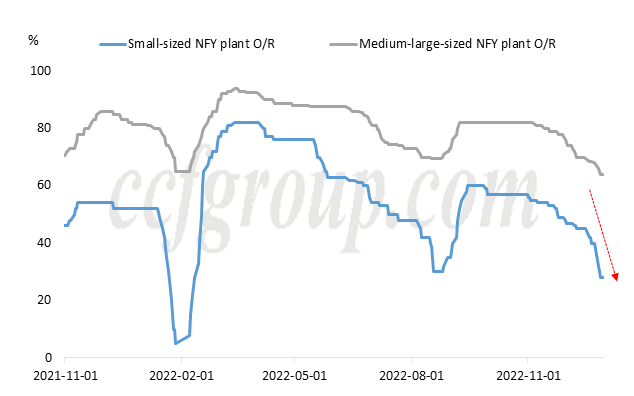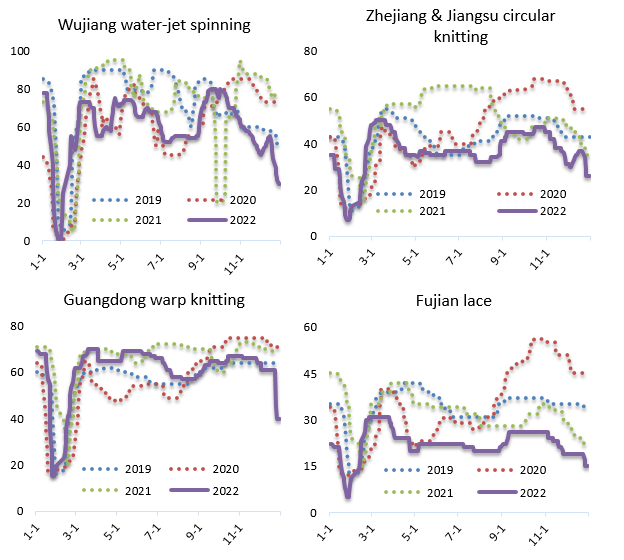Nylon textile filament forecast adjusted, after the other shoe falls
It has been more than three weeks since China readjusted its pandemic prevention policy and fully opened up. Two weeks ago, the market still could not predict a precise time of the peaking of the pandemic and whether it would affect the resumption of work after the Spring Festival. At the beginning of China's reopening, the infection rates varied greatly among regions, but after nearly two weeks of full transmission, the infection rates between different regions have been basically synchronized. A rough estimate indicates that around 70-80% of the population could been infected already in many regions. Moreover, the traffic flow and subway passenger flow have been gradually restored, and the initially infected people have gradually returned to work. There are signs that the previously inconclusive peak of infection has arrived and the market is improving.
The peak of the pandemic has come so fast that it has some impacts on the market:
1. Some enterprises are accelerated to shut down for Spring Festival.


Around December 20, the number of infection cases increased exponentially. The number of infections in nylon textile filament mills and fabric mills increased sharply, and workers were severely insufficient. Some small factories simply stopped production in advance for Spring Festival (which is to start in the middle of January 2023), and medium and large manufacturers were also gradually speeding up the pace of production cut to ease the pressure of labor force. By the end of December, the average operating rate of the industry has dropped to 57%, of which the average load of small factories as to less than 30%.
As the first wave of infected workers recovered and returned to work, a small number of filament factories with low inventory returned to work and ramped up production. However, for fabric mills, if it is not for the rush, they will not resume production again before the Spring Festival, and there are very few fabric factories still have orders to catch up.
2. Lifted the panic about the unknown.
Before the peak of infection, there is no actual data reference for the prediction of the impact in the middle and downstream of the industry, so enterprises had been generally cautious about returning to work after the Spring Festival, and they were unable to assess whether to stock or arrange production in advance. However, with the arrival of the peak of infection, people also have a clearer judgment on the resumption of work after the Spring Festival. According to the current degree of infection and recovery cycle, the impact of the pandemic on enterprises returning to work after the Spring Festival can basically be ignored, no matter from the physiological or the impact on the market, the panic has been significantly alleviated.
3. A slight increase in market confidence after the Spring Festival
The peak of infection has come, and the expectation of the impact from the pandemic after the Spring Festival is expected to decline significantly. Fabric mills' bearish outlook toward the market after the Spring Festival has gradually eased. With the passage of time, fabric mills who have kept wait and see are not too optimistic about the demand after the Spring Festival, but they may be relatively optimistic about the trend of raw materials. Fabric mills with relatively stable orders will gradually show their willingness to prepare goods before the Spring Festival.
At present, the market is relatively optimistic about the expectations of China domestic sales after the Spring Festival, while the direct correlation between terminal export and the liberalization of pandemic prevention policy is low. Moreover, the peak of infection has also led to an increase in the difficulty of refunding before the Spring Festival, and high inventory, tight funds, slow recovery of orders, and so on, are still the main reasons why fabric mills are not restocking too much before the Spring Festival.
- Top keywords
- Cotton Price
- Cotton Futures Price
- Cotton Futures
- CZCE
- PTA Futures Price
- Chemical Fiber
- Polyester Prices
- Wool price
- PTA Futures
- Shengze Silk
- China
- Yarn Price
- price
- China Textile City
- Fibre Price
- Benzene Price
- Cotton
- Index
- Cotton Index
- PTA
- fabric price
- NYMEX
- Top 10
- textile industry
- Spot Cotton
- Cotton Yarn
- Polyester Price
- Futures
- PTA Price
- cotton yarn price

